Volodalen Training Camp in the 1960s
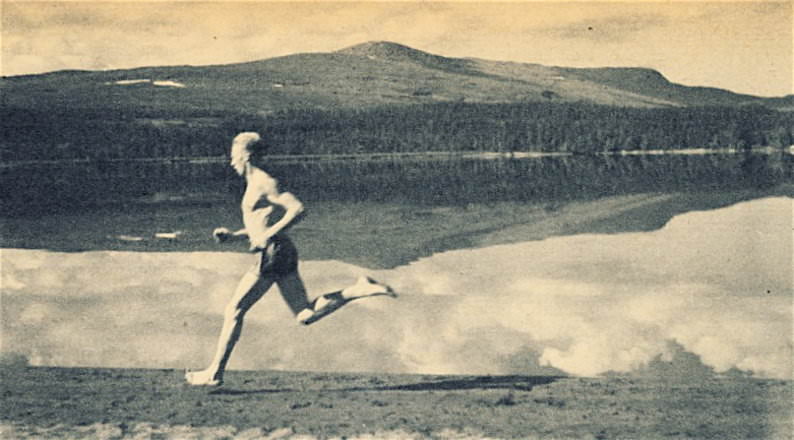 |
| 1948 Olympic gold medalist Henry Eriksson trains on the sand of Lake Nulltjärn. |
As altitude training became increasingly de rigueur in the late 1960s, serious distance runners began to choose the high mountains for their intensive training. Before this change, there were a few popular training camps that were closer to sea level. One of the most celebrated was Percy Cerutty’s Portsea Camp in Australia. Britain developed camps at Timsbury Manor and Merthyr Mawr. Sweden had two: one outside Stockholm called Boson and one further north in Jamtland, Volodalen.
Volodalen became increasingly popular as it developed over the 1930’s and 1940’s, catering not only to top-class runners but also to competitive skiers, skaters and canoeists. It first gained international attention when Gunder Hagg did a lot of his training there. Following World War Two, Olympic medalists Henry Eriksson, Lennart Strand, Alain Mimoun, Marcel Hansenne and Gaston Reiff trained there. Later such great runners as Michel Jazy, Jean Wadoux, Marian Haro, Gaston Roelants, Dave Bedford and Anders Garderud were Volodalen visitors.
There were three reasons why runners made the far-from-easy journey north to the Volodalen centre. First, it was set in a remarkable natural location of unspoilt forests, rivers and mountains. Second, it provided excellent natural training venues. And third, it was run by a truly remarkable man, Gösta Olander.
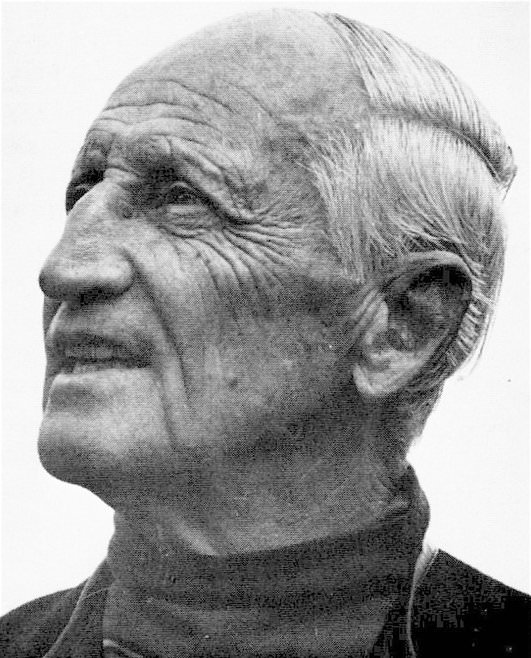 |
Olander (1893-1972) grew up in Jamtland. Until he was 38 he worked as a ski leader and instructor. Although he didn’t excel in competitive sports, he was the first to climb Sweden’s highest mountain, Kebenkaise, in winter. Deciding to settle down at the age of 38, he leased a small Swedish Tourist Association hostel (20 beds) near a Lapp village in Jamtland. During the 1930s and 1940s, with the help of his wife Olga, he developed Volodalen into “something of an athletes’ Mecca.” (Gunvald Hokanson, Volodalen, 1953)
Gösta Olander was a truly remarkable man, excelling in many areas apart from coaching, ski instructing and tour-guiding. He made important contributions as a film-maker, photographer, writer, naturalist, author, art collector, and zookeeper. This renaissance man also found time to develop Volodalen into a formidable turiststation of two hotels and some 20 houses that could accommodate well over 100 guests. Facilities included a ski lift, a ski jump, a 300m track, a gym and a sauna. But most valuable of all were the natural facilities that abounded in this remote valley.
Facilities
A visiting runner in the 1960’s had a wide choice of training venues.
1. The Moss. Large areas of soft and giving moss covered some of the marshland and lakes. The moss was generally used for warm-up and warm-down, but it could accommodate a whole session.
2. The Lake. Lake Nulltjärn lay about 3K beyond the turiststation—a perfect distance for a gentle warm-up. The shoreline of the lake had a firm 1,000m sandy stretch, as well as some small sandhills high enough for resistance training.
3. The 220m Path. This special path was used regularly for interval training. Its unique features are discussed below.
4. The 330m Track. Made of cinder and mud, it was very hard and was generally avoided by distance runners. Facilities for all track and field events were available.
5. The Mountain and Forests. A wonderful variety of terrain was available for steady running or fartlek. A favorite was the trail that climbed nearly 1,000m to the summit of Ottfjället (1265m).
6. The Road. the quiet and well-maintained dirt road offered a safe running surface that was more giving than tarmac.
7. The 800m Loop. This was mainly used for time-trials. It was a there-and-back course over a 400m level and wide path. The turnaround was a thin tree that runners swung around. The bark at shoulder height was smooth from the wear of many hands. In 1966, Jean Wadoux held the record at 1:49.0.
-------
Although distance running was just one of Olander’s interests, I got the impression that it was his strongest. He believed in a natural approach to training. Like Cerutty, he studied the movement of animals to improve his understanding of the human running action. As well, he was able to inspire his runners, as many have attested. When I was there in 1966, he was always out at 4pm to supervise training. He was extremely proud of his association with Gunder Hägg and was known to show his film of this great Swedish runner to anyone interested.
Over the years Olander developed some original training concepts that utilized the Jamtland terrain and climate. Some of these concepts anticipated later developments in distance training.
Resistance Running
|
|
| Gunder Hägg (closest) trains in knee-deep snow. |
Olander’s first great runner, Gunder Hagg, did a lot of his basic conditioning in deep snow. There is film of Hagg doing this kind of resistance work, as well as a photo showing him moving in knee-deep snow. Clearly in the long northern winters at Valadalen, running in snow was unavoidable, but Olander turned it into a key conditioning activity. In the summer, he used the small sandhills at Nulltjärn for speed resistance running.
Specialized Interval Training
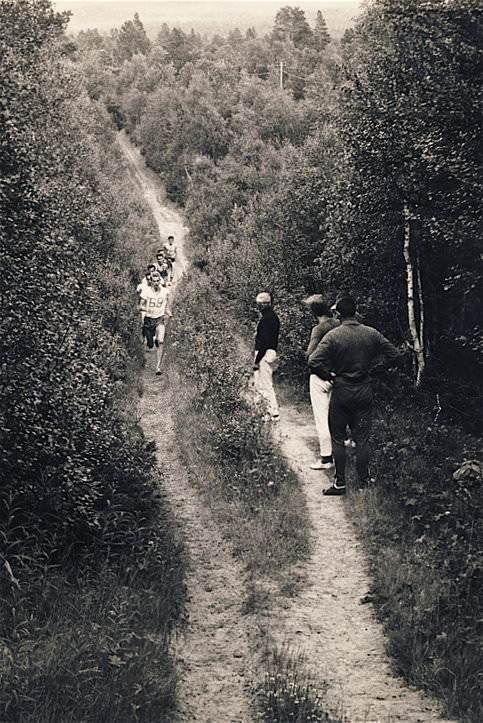 |
| Anders Garderud leads a group of Spanish runners on the 220m path. Gösta Olander (in black top) stands at the 150m mark. Note the narrow trench. |
Olander’s special 220m straight path was used a lot in the summer. A crucial aspect of this path is a shallow 35cm-wide trench in the middle, in which runners had to plant their feet. This trench was created by Olander to improve the balance of runners. Another crucial aspect was that the gradient of the first 150m was slightly downhill, while the last 70 was increasingly uphill until very steep at the end. The purpose here was to allow runners to establish a fast speed and then require them to hold their form at the end, where the path became increasingly steeper.
While athletes ran repetitions on this path, Olander, stopwatch in hand, would wait at the 150 mark, just past where the path began to climb—the place where the runners were at top speed. He would often step into the path as the runners approached in order to get a head-on view of the runner’s form.
Therapeutic Running
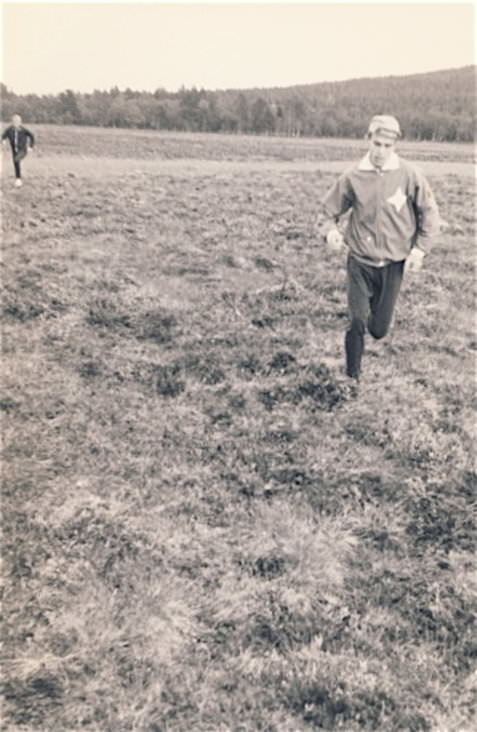 |
| Ole Andersson of Södertaljetrains on the moss. |
This most original activity involved running on the moss covering marshland and small lakes around Volodalen. Running on such moss is hard work in that the moss yields about 7.5cm (3 inches). In effect, Moss running is yet another form of resistance running, albeit a gentle one. An easy pace was recommended as forward movement was not easy. The main advantage of running on this moss was that there was no jarring. It was thus ideal for warm-up and warm-down as well as for complete sessions. It was ideal for those with sore or stiff legs, much like pool-running is. A visiting medical expert claimed that half an hour’s running on this moss was worth an hour’s massage.
Barefoot Running
In the summer this was encouraged. Barefoot running was done along a 1,000m stretch of shoreline at Nulltjärn Lake and on the adjoining sandhills. It could also be carried out on the moss surfaces. This type of running fits well into the natural emphasis of Olander’s training philosophy.
-------
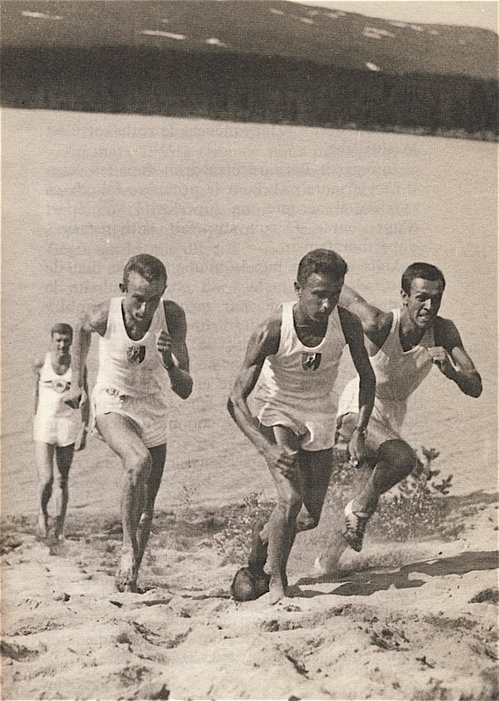 |
| Michel Jazy tackles the sandhill. Jean Wadoux (left) is close behind. |
Perhaps the best way to understand why so many runners raved about Volodalen, is to view the 10-minute film on ina.fr. (Just google Volodalen and you will find it on the first page.) The 1963 film has a commentary in French and coverage of Jazy’s spiking injury, but there is some great footage of moss running (2:25-3:00), the 220m path (4:17-5:00), and the sandy lakeshore (9:15-9:50). As well, you will see the spry 70-year-old Olander running with the French group. Above all, the black-and-white film manages to convey the uplifting atmosphere of Volodalen.
Jazy, who always preferred to train in nature, wrote lyrically about Volodalen in his book. “The landscape there has an extraordinary nobility and purity, and the air has a quality that I have not experienced anywhere elsewhere. I have often gone to Volodalen with other French athletes; it was always a moving experience. Far from the world and from noise, it was a radiant and contemplative retreat. I ran at Volodalen with uninhibited pleasure, like an animal. I rediscovered at Volodalen the true taste of innocence and of lost pleasures. When I returned to Paris after two or three weeks there, I felt I had become not only stronger physically, but also—dare I say it?—better morally.” (Mes victories, mes défaites, ma vie, p. 230)
Conclusion
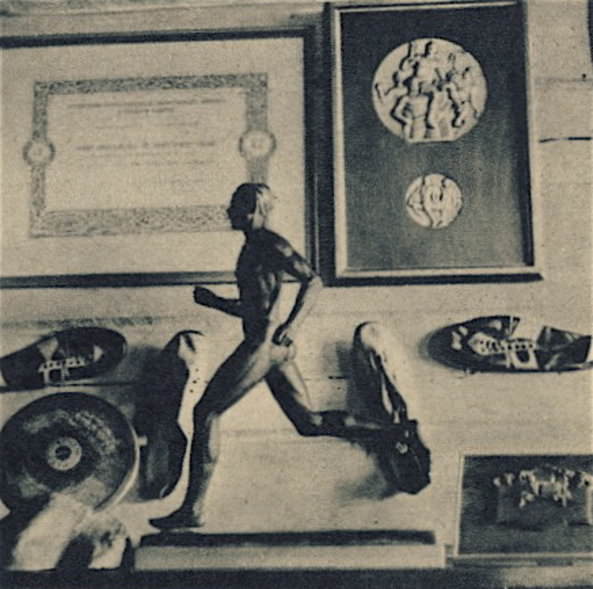 |
| Some of Olander's collection:shoes worn by Hägg and Reiff while setting WRs; a statue of Hägg by Olof Ahlberg; Consolini's WR discus. |
The Volodalen Turiststation was at its zenith as a runner’s “Mecca” in the 1950s and 1960s. Its success was due largely to Gösta Olander’s enthusiasm and hard work. A summer visitor in the 1960s would have been impressed by the decor of the main building, the superb buffet meals and the hospitality of the staff. These, combined with the beautiful and unspoilt environment made for a memorable stay. With the death of Olander in 1972 and the emerging requirement for altitude training, distance runners began to choose Fort Romeu or San Moritz instead of Volodalen. Since those days, the turiststation has grown considerably and can now accommodate over 200 guests. In the winter it still offers downhill and cross-country skiing, skating, as well as a new 18-lane biathlon facility. In the summer there is fishing, orienteering and hiking. But the top runners no longer go there. 
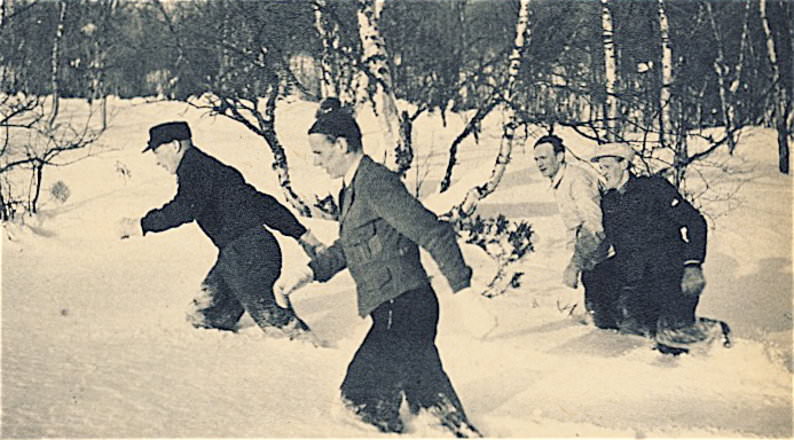
5 Comments